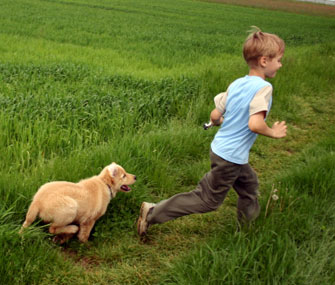How to Stop a Dog From Nipping at Your Heels
Published on December 17, 2013
Skip To

Q: My dog is a heel nipper. She’s not aggressive, and only makes minimal contact with her mouth, but she reacts to movement, especially kids running. What can I do?
A: This behavior is unlikely to stop on its own; unless you intervene, it will become a habit. To put a stop to the nipping, it is important to avoid any situations where your dog would normally chase while also teaching her alternative behaviors to perform instead.Dogs should always be supervised around children, especially when a dog exhibits unpredictable behavior like heel nipping. This behavior is frightening for a child. Unfortunately, the more the child screams and tries to get away, the more exhilarating and intense the situation becomes for your dog. This makes it more likely that your dog will respond with harder or more frequent heel nips or that she may jump up to nip the child’s arms and sleeves.
Teach Your Dog an Alternative Behavior
It is important that you teach your dog an alternative behavior, like down stay, to replace the nipping. Work with your dog on leash in a location with minimal distractions. Once she is successful at down stay, add distractions like someone walking by. Build up to more dramatic distractions, like a person jogging by or jumping up and down. Once your dog is comfortable holding a down stay even with these distractions, move your training to a more challenging environment, one where your canine would normally chase — your backyard, for instance.The down stay is not the only alternative behavior you can teach your dog. Some dogs prefer more active behaviors like jump, spin and roll over. No matter what replacement behavior you are teaching, start in a low-distraction environment and slowly add more distractions as your dog masters the new behavior.
Teaching your dog to heel can also eliminate nipping in some cases. Train the heel initially at a slow pace, such as a walk, where your dog is less likely to get excited and nip. Once your dog is reliably heeling, speed up to a fast walk, then (depending on your dog’s overall health) a slow jog and eventually a run. Reward your dog with treats, toys and praise for staying at your side. Ideally, this behavior will become so fun for your dog that getting to run with you becomes its own reward. A word of caution: It’s always best to talk to your veterinarian before starting a running program, or any other strenuous exercise program, with your dog.
If your dog becomes overstimulated during a run and nips at your heel, stop and freeze in place. Return your training to an easier level, like heeling while walking, and build back up to running.
Help Your Dog Succeed
No matter what replacement behavior you teach your dog, it’s important to set her up for success. Even after training, there may still be situations that are too intense for your dog to handle. For instance, your dog may be able to play nicely with your children but may get overly excited when the neighbor kids come to your house. In this case, it would be better for your dog — and the children — if she stayed in the house rather than outside in the yard with the kids.Providing physical and mental outlets for your dog’s energy can also help decrease heel nipping. While any breed of dog may be a heel nipper, those with a herding background are more likely to exhibit this behavior. When herding dogs lack a job to do, their vigilance and motion sensitivity find other outlets, like chasing after bikes, cars or running children. These dogs need regular exercise and challenge. Otherwise they devise their own games to expend energy.
Walks around the block are often not enough for many of these dogs. Exercise for a high-energy breed may mean going for longer or faster walks, playing active games or enrolling in a doggy sport. You can also train your dog to herd in a controlled manner by enrolling in Treibball. Fetch, Frisbee and structured games of tug also allow your dog to release pent-up energy.
It’s also important to give your dog the opportunity to act out her predatory behavior in a safe manner. Tie a stuffed animal to the end of a rope or use a Chase-It toy for playtime.
Finally, fear, anxiety and conflict can also cause heel nipping. Some dogs heel nip when they become nervous with a situation or a person. If you suspect your canine’s heel nipping is caused by fear or anxiety, seek immediate professional help. Talk to your veterinarian, who may refer you to a veterinary behavior specialist or certified professional dog trainer to help put a stop to this behavior.





